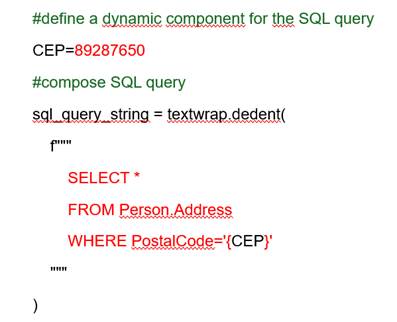.png)
Ao contrário do filme, citado através da imagem (para quem não conhece, Matrix, 1999), a escolha entre Dynamic SQL e Embededd SQL, não é uma escolha entre a verdade e a fantasia, mas, mesmo assim é uma decisão a ser tomada. Abaixo, tentarei facilitar a escolha de vocês.
Caso sua necessidade seja interações entre o cliente e a aplicação (consequentemente o banco de dados), o Dynamic SQL pode ser mais apropriado, pois “molda-se” muito facilmente com estas alterações de consultas. Entretanto, este dinamismo tem um custo, a cada consulta nova, ela é remodelada, podendo ter um custo maior para a execução. Abaixo um exemplo simples de um trecho de código Python.

Exemplo de SQL Dynamic
Apenas com base na informação acima, o Embededd SQL é a melhor escolha? Depende. Pensando única e exclusivamente em agilidade na execução, poderíamos partir para esta escolha. Uma vez que as instruções SQL são inseridas diretamente no código de programação, utilizando-se de variáveis HOST para entrada e saída de dados. O objetivo também não é ensinar como utilizar uma ou outra opção, e sim abrir a mente para possibilidade, conhecendo um pouco sobre cada um.
Abaixo, temos algumas características relevantes e que devem ser levadas em consideração quando iniciar um desenvolvimento que exija uma consulta SQL:
Como já mencionado, o Embededd SQL é várias lembrado pelo seu desempenho, mas, isto não é uma corrida e nem só de velocidade se vive. Sua integração com diversas linguagens de alto nível, fazem com que os desenvolvedores possam utilizar os recursos de melhor forma, isto dá-se devido ao fato de não precisarem de tantas buscas em arquivos externos ou scripts separados, tornando o código mais limpo e sustentável.
É notado também pela sua consistência, afinal, alterações no banco de dados podem ser espelhadas no código SQL, evitando assim possíveis inconsistências nos dados. E por final, porém não menos importante, o fato das consultas estarem dentro do código, torna-o mais seguro, pois podem ser implementados controles de acesso diretamente no aplicativo, evitando assim acessos não autorizados e consultas indevidas.
Bom, agora podemos ver o que sustenta o Dynamic SQL. Este dinamismo é facilmente notado em sua flexibilidade, isto é, tudo é moldado enquanto está acontecendo, consultas, condições e até nomes de tabelas ou campos, beneficiando assim o cliente, o usuário. É marcado também pela facilidade de administração, uma vez que os DBAs conseguem realizar manutenções nos dados e bancos, conferindo em tempo real o impacto causado, evitando assim maiores problemas de compilação.
O resumo de toda esta informação, com mais teoria e pouca “prática” é que não há um lado certo ou um lado errado, até mesmo um vilão ou um mocinho, o fato é que o conhecimento sobre o que será desenvolvido, uma análise profunda das necessidades, levará a uma escolha...
De qual lado da força você estará?

.png)
.png)